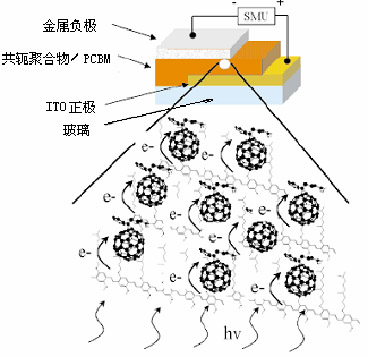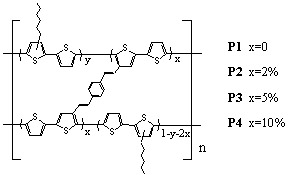| |
Under the financial support of NSFC, The Ministry of Science and Technology of China, Chinese Academy of Sciences (CAS) and the Institute of Chemistry (ICCAS), Prof. Yongfang Li’s group in CAS Key Laboratory of Organic Solids, ICCAS, made important progress in the studies of photovoltaic conjugated polymers recently. Their related results applied Chinese Invention Patent and published in the journals of J. Am. Chem. Soc., etc.
Polymer solar cells (PSCs) are composed of a blend film of a conjugated donor and a acceptor (PCBM) sandwiched between ITO anode and a metal cathode. (see Figure 1) PSCs have attracted great attentions in recent years, because of its advantages of low cost, light weight, easy preparation and possibility to be fabricated into flexible devices. But the power conversion efficiency of the PSCs is low (< 5%) at present in comparison with the commercial inorganic solar cells. One of the reasons is the narrower absorption band of the conjugated polymers used at present (mainly poly(3-hexylthiophene) (P3HT)), which results in a low utility of the solar light. Another reason is the lower charge carrier mobility of the conjugated polymers, which results in a lower charge transportation efficiency. Therefore, design and synthesis of new conjugated polymers with broader absorption and higher charge carrier mobility are very important for improving the power conversion efficiency of the PSCs.
Li’s group began their studies of PSCs from 2000, on the basis of their strong background on the electrochemistry of conducting polymers and the polymer light-emitting electrochemical cells (LECs). After several years research efforts, they made important progress in the studies of the broader absorption and high mobility conjugated polymers recently. Jianhui Hou (graduate student) from his group designed and synthesized a series of side chain conjugated polythiophenes. By prolonging the conjugation length of the conjugated side chains and controlling the ratio of the units with the conjugated side chains in the polythiophene main chains, the new polythiophene derivatives with broad absorption band and strong absorbance in the visible region were obtained. (Jianhui Hou, et al., Macromolecules, 2006, 39: 594-603,Chem. Commun.,2006, 871-873). A bithienylenevinylene substituted polythiophene shows a broad and strong absorption peak covering the range of 380 nm ~ 650 nm (P3 in Figure 2). With this polymer as the donor blended with PCBM (1:1, w/w), Zhan’ao Tan (graduate student) obtained a power conversion efficiency of 3.18% of the PSC under the illumination of AM1.5, 100 mW/cm2, which is 38% higher than that of P3HT under the same experimental conditions.(Jianhui Hou, Zhao’ao Tan, et al, J. Am. Chem. Soc., 2006, 128: 4911-4916.) This efficiency is the highest for the new conjugated polymers (except of the traditional P3HT) reported till now. In addition, Erjun Zhou (Graduate student) recently also made progress in the studies of high mobility conjugated polymers. He designed and synthesized a kind of cross-linking polythiophene with conjugated phenylenevinylene bridges(see Figure 3). Hole mobility of the polymer with 5% conjugated bridge increased two orders than that without the conjugated bridges, and the photovoltaic properties were also enhanced after the cross-lingking(Erjun Zhou, et al., Macromol. Rapid Commun. 2006, 27: 793–798, in press)。

Figure 1 Composition and structure of polymer solar cells

Figure 2. Molecular structure, absorption spectra and input photon to converted current efficiency (IPCE) of P3HT and the bithienylenevinylene substituted polythiophenes

Figure 3. Cross-linking polythiophene with conjugated phenylenevinylene bridges , |
|
